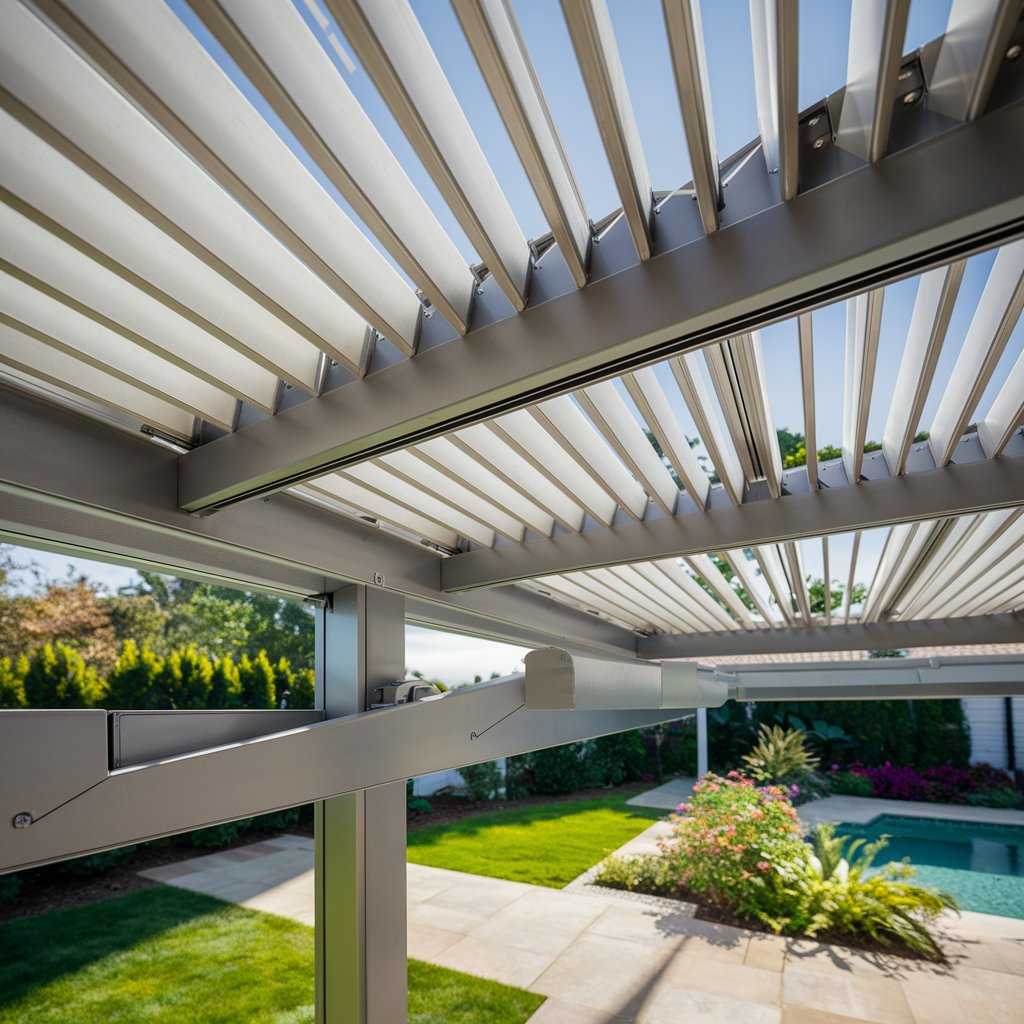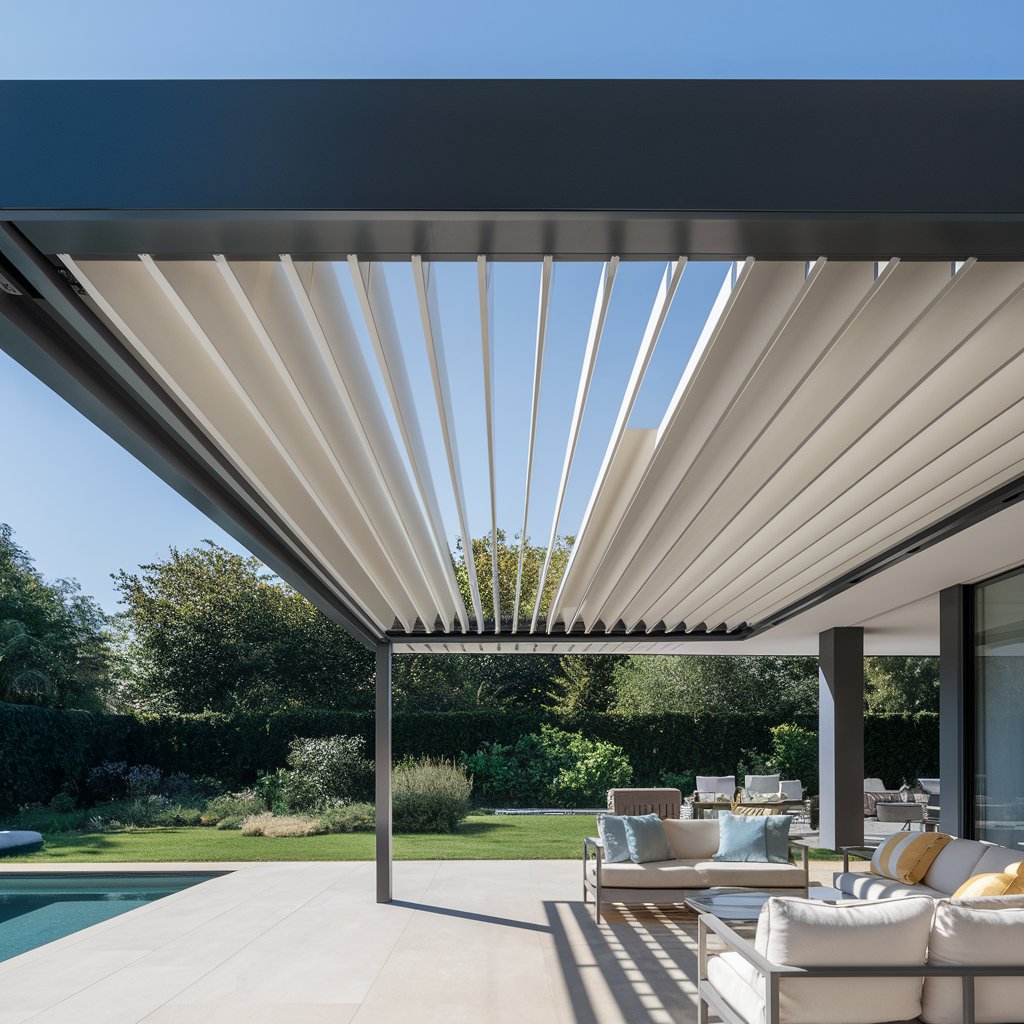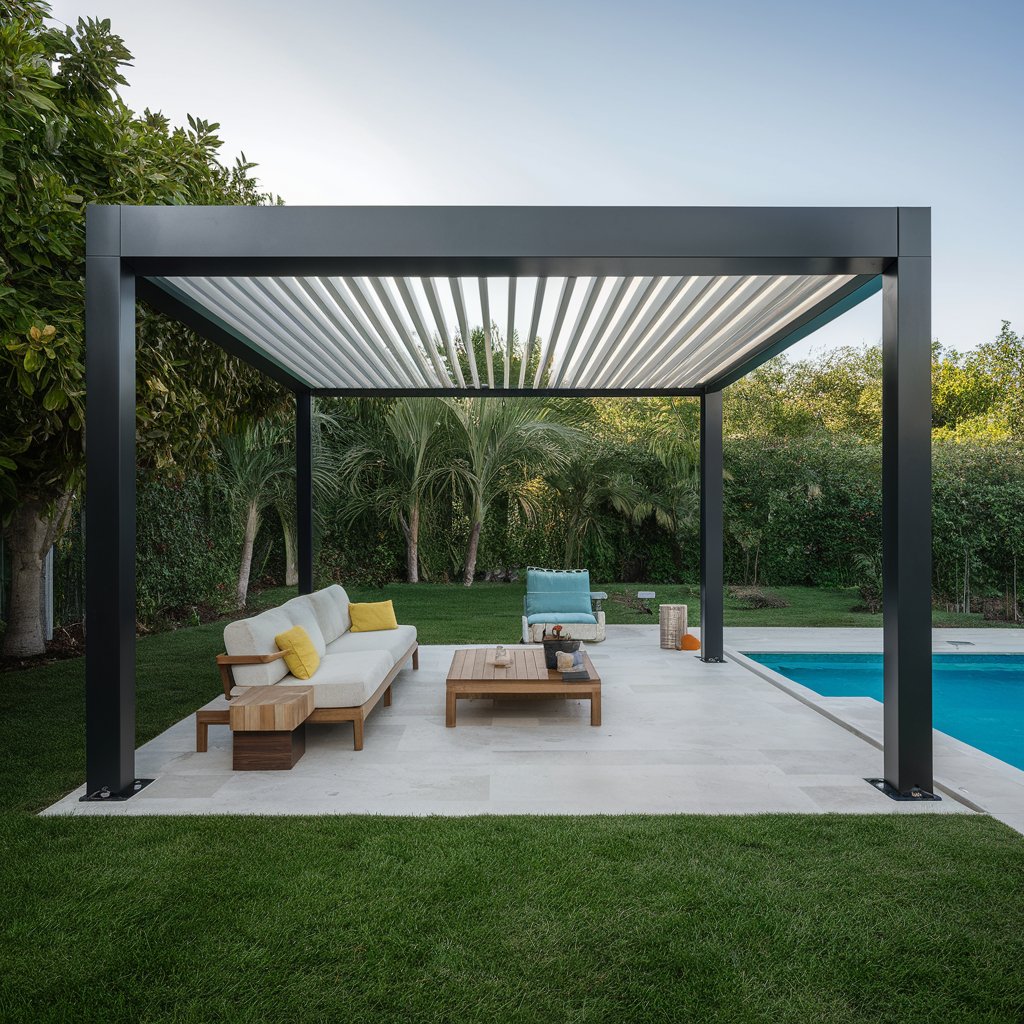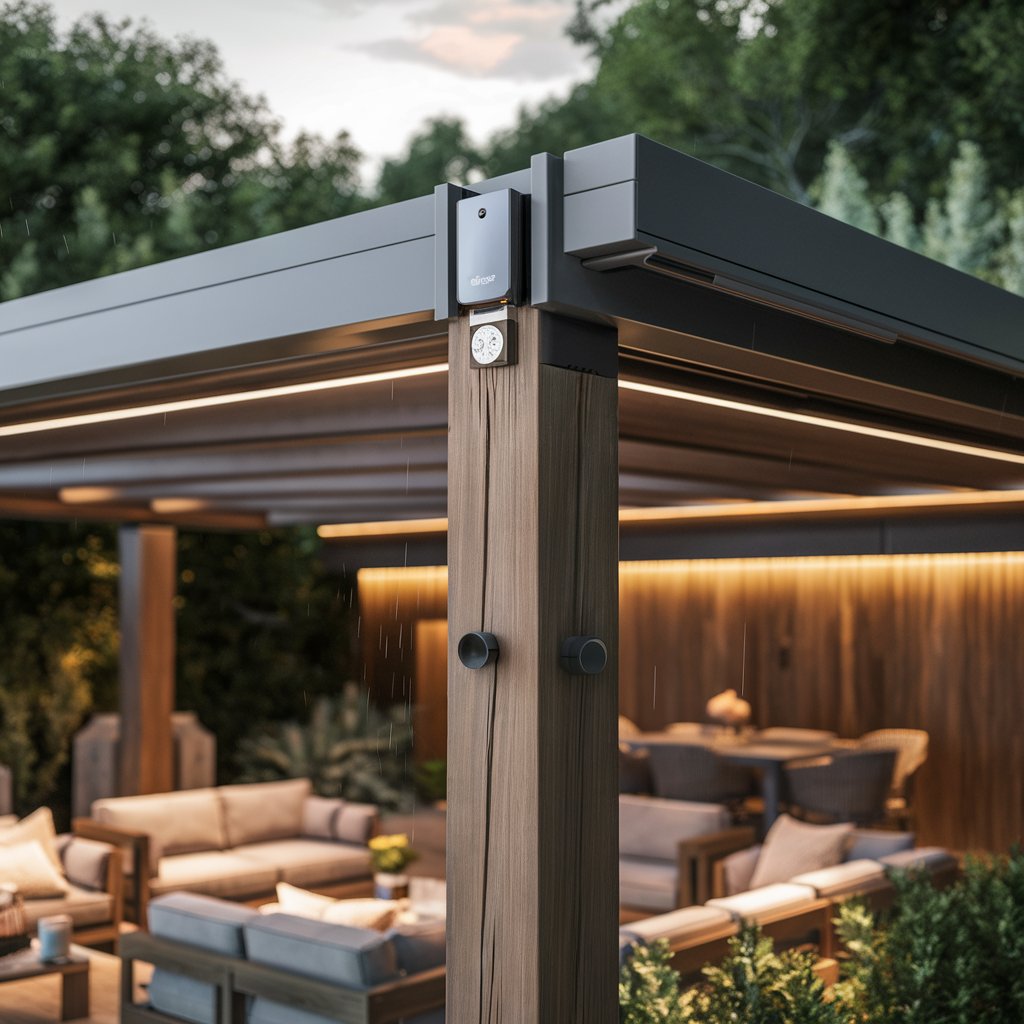In the world of outdoor living spaces, the pergola stands out as a versatile and elegant structure that enhances the functionality and aesthetics of any yard, patio, or garden. Pergolas are no longer just static, decorative elements; the advent of louvered pergolas has introduced a new level of adaptability and comfort. The louvers in these pergolas can be adjusted to control sunlight and ventilation, creating a dynamic outdoor environment. A significant decision when installing a louvered pergola is whether to choose a motorized or manual system. This comprehensive guide will explore the nuances of both motorized pergola and manual louvered pergola, detailing their features, benefits, drawbacks, and considerations to help you make the best choice for your needs.
What is a Louvered Pergola?
A louvered pergola is a structure composed of a series of adjustable slats, known as louvers, which can be tilted to various angles. These louvers can be opened to let in sunlight and air or closed to provide shade and protection from rain. The adjustability of the louvers makes these pergolas highly versatile, offering a customizable outdoor experience. Louvered pergolas can be made from various materials, including wood, aluminum, and vinyl, each offering different levels of durability, maintenance, and aesthetics.
Motorized Louvered Pergolas
Motorized louvered pergolas are equipped with a motorized mechanism that allows the louvers to be adjusted using a remote control, smartphone app, or integrated home automation system. These pergolas are designed for ultimate convenience and modern luxury.
Features and Benefits:
- Convenience and Ease of Use: The primary advantage of a motorized pergola is the convenience it offers. With the push of a button, you can adjust the louvers to your desired angle, without having to leave your seat. This is particularly beneficial in large outdoor spaces or when frequent adjustments are needed.
- Precision Control: Motorized systems provide precise control over the position of the louvers, allowing for incremental adjustments to create the perfect balance of sunlight and shade. This precision can enhance comfort and protect furniture and other outdoor elements from excessive sun exposure.
- Weather Sensors: Many motorized pergolas come equipped with sensors that detect weather changes and adjust the louvers accordingly. For example, rain sensors can automatically close the louvers to keep your outdoor space dry, while wind sensors can adjust the louvers to reduce wind resistance and prevent damage.
- Luxury and Modern Aesthetics: Motorized pergolas often feature sleek designs and cutting-edge technology, making them a luxurious addition to any outdoor space. The automated operation adds a touch of modern sophistication, enhancing the overall aesthetic appeal of your home.
- Integration with Smart Home Systems: Motorized pergolas can be integrated with existing smart home systems, allowing you to control them alongside other automated features like lighting, heating, and security systems. This integration provides a seamless and convenient user experience.
Drawbacks:
- Higher Cost: The advanced technology and additional components required for motorized systems make them more expensive than manual pergolas. The initial investment is higher, and there may also be ongoing costs for maintenance and repairs.
- Maintenance and Repairs: The motor and electronic components of motorized pergolas may require regular maintenance to ensure smooth operation. Repairs can be more complex and costly compared to manual systems, especially if specialized parts are needed.
- Power Dependency: Motorized pergolas require a power source to operate, which can be a limitation in areas without easy access to electricity. Solar-powered options are available, but they may not be as reliable in regions with limited sunlight.
Manual Louvered Pergolas
Manual louvered pergolas operate using a hand crank or lever system to adjust the louvers. While they lack the automation and convenience of motorized systems, they offer simplicity and reliability.
Features and Benefits:

- Cost-Effective: Manual pergolas are generally more affordable than motorized systems, making them an attractive option for budget-conscious homeowners. The lower initial cost allows for more flexibility in budgeting for other outdoor improvements.
- Simplicity: The absence of electronic components makes manual pergolas straightforward to operate and maintain. There are fewer parts that can malfunction, reducing the need for repairs and maintenance.
- Durability: Manual systems are often more durable due to their simplicity. The lack of motors and electronic parts means there is less that can go wrong, resulting in a longer lifespan for the pergola.
- Independence from Power Supply: Manual pergolas do not require electricity to operate, making them suitable for remote locations or areas without reliable access to power. This independence can be a significant advantage in off-grid settings.
- Lower Maintenance: With fewer mechanical components, manual pergolas typically require less maintenance. Regular cleaning and occasional lubrication of the moving parts are usually sufficient to keep them in good working order.
Drawbacks:
- Effort Required: Adjusting the louvers manually requires physical effort, which can be inconvenient, especially for individuals with limited mobility or during extreme weather conditions. This effort can also be a deterrent for frequent adjustments.
- Less Precision: It can be challenging to achieve the same level of precision in louver positioning with a manual system as with a motorized one. Fine-tuning the angle of the louvers to achieve the perfect balance of light and shade may require more time and effort.
- Basic Aesthetics: While still attractive, manual systems may lack the sleek, modern look that motorized pergolas offer. The presence of a manual crank or lever can be less visually appealing than a hidden motorized mechanism.
Detailed Comparison: Motorized vs. Manual Louvered Pergolas
To provide a thorough comparison, let’s delve into various aspects that might influence your decision between motorized and manual louvered pergolas.
1. Installation
- Motorized Pergolas: Installation of motorized pergolas is more complex due to the need for electrical wiring and integration of the motor and control systems. This often requires professional installation, which can add to the overall cost.Manual Pergolas: Manual pergolas are simpler to install, often requiring only basic tools and skills. This can be a DIY project for those with some construction experience, reducing installation costs.
2. Control Mechanisms
- Motorized Pergolas: Controlled via remote, smartphone apps, or integrated home systems. Some models offer voice control compatibility with smart home devices like Amazon Alexa or Google Home.Manual Pergolas: Adjusted using a hand crank, lever, or pulley system. While effective, these methods require manual effort each time an adjustment is needed.

3. Customization and Flexibility
- Motorized Pergolas: Highly customizable with options for automated features like weather sensors and programmable settings. The ability to integrate with other smart home devices adds to their flexibility.
- Manual Pergolas: Offer fewer customization options. Adjustments are limited to what can be achieved manually, and there are no automated features.
4. Aesthetics and Design
- Motorized Pergolas: Often designed with sleek, modern aesthetics in mind. The hidden motors and clean lines contribute to a sophisticated look.
- Manual Pergolas: While still attractive, the presence of manual adjustment mechanisms can detract from the overall aesthetic. However, they can still be designed to complement various architectural styles.
5. Maintenance and Durability
- Motorized Pergolas: Require regular maintenance to ensure the motor and electronic components function correctly. The complexity of the system means that repairs can be more involved and costly.
- Manual Pergolas: Generally more durable due to the absence of electronic parts. Maintenance is minimal and usually limited to cleaning and lubricating moving parts.
6. Weather Resistance
- Motorized Pergolas: Advanced models can automatically adjust to protect against weather changes, providing superior protection from rain, wind, and harsh sunlight.
- Manual Pergolas: Depend on the user to make adjustments. This can be less efficient in sudden weather changes, potentially exposing the area to unwanted elements.
7. User Experience
- Motorized Pergolas: Offer an enhanced user experience with minimal effort required to adjust settings. The ability to make adjustments remotely or automatically is a significant advantage.
- Manual Pergolas: Provide a more hands-on experience. While functional, the need for manual adjustments can be less convenient, particularly for frequent changes.
8. Environmental Impact
- Motorized Pergolas: Depending on the power source, they can have a higher environmental impact due to energy consumption. Solar-powered options are available but may not be as reliable.
- Manual Pergolas: Have a lower environmental impact as they do not require electricity. This makes them an eco-friendlier option.
Choosing the Right Pergola for Your Needs
When deciding between a motorized and manual louvered pergola, consider the following factors to determine which option best suits your needs and preferences.
1. Budget:
- Evaluate your budget to determine how much you are willing to invest in your pergola. Motorized systems have a higher upfront cost, while manual systems are more affordable. Consider not only the initial purchase price but also potential installation and maintenance costs.
2. Usage Frequency:
- Think about how often you will use the pergola and adjust the louvers. If you plan to make frequent adjustments to respond to changing sunlight and weather conditions, a motorized system can save time and effort. For occasional use, a manual system may be sufficient.
3. Climate:
- Consider the climate in your region. In areas with unpredictable or harsh weather conditions, the automated features of a motorized pergola, such as rain and wind sensors, can provide added protection and convenience. In more temperate climates, a manual system may be adequate.
4. Aesthetics and Design Preferences:
- Reflect on your design goals and the overall aesthetic of your outdoor space. Motorized pergolas often offer a more modern and sleek appearance, while manual pergolas can be tailored to blend with various architectural styles. Choose a pergola that complements the design of your home and outdoor area.
5. Convenience and Lifestyle:
- Assess your lifestyle and how much convenience matters to you. If you value the ease of automation and the ability to control your pergola remotely, a motorized system is the better choice. If you prefer simplicity and don’t mind manual adjustments, a manual pergola will suffice.
6. Long-Term Considerations:
- Think about the long-term implications of your choice. While motorized pergolas offer advanced features and convenience, they may require more maintenance and repairs over time. Manual pergolas are generally more durable and require less upkeep.
Case Studies and Real-Life Applications
To provide a better understanding of how motorized and manual louvered pergolas perform in real-life scenarios, let’s look at some case studies and applications.
Case Study 1: The Luxury Patio
A homeowner in a coastal region decided to install a motorized louvered pergola to create a luxurious outdoor living space. The motorized system included weather sensors that automatically adjusted the louvers based on the weather conditions. During a sudden rainstorm, the rain sensors closed the louvers, keeping the patio furniture dry. On sunny days, the homeowner could easily adjust the louvers to create the perfect balance of shade and sunlight using a smartphone app. The integration with the home’s smart system allowed for seamless control of outdoor lighting and heating, enhancing the overall experience. The motorized pergola added significant value to the property and provided a sophisticated, modern aesthetic.
Case Study 2: The Budget-Friendly Garden
In a suburban neighborhood, a family opted for a manual louvered pergola to create a shaded area in their garden. The manual system was chosen due to its affordability and simplicity. The family enjoyed the hands-on approach to adjusting the louvers to control sunlight and ventilation. The pergola provided a charming, rustic look that complemented the garden’s design. Despite the need for manual adjustments, the family found the pergola easy to operate and appreciated the lower maintenance requirements. The manual pergola proved to be a durable and cost-effective solution for their outdoor space.
Case Study 3: The Remote Retreat
A couple with a remote vacation cabin chose a manual louvered pergola due to the lack of reliable electricity in the area. The pergola provided a perfect blend of functionality and aesthetics, offering shade during hot days and protection from rain. The manual operation suited the remote setting, and the pergola’s simplicity ensured minimal maintenance. The couple enjoyed the hands-on experience of adjusting the louvers and appreciated the eco-friendly nature of the manual system. The pergola became a focal point of their outdoor retreat, providing a versatile space for relaxation and entertainment.
Conclusion
Both motorized and manual louvered pergolas offer unique advantages that cater to different needs, preferences, and budgets. Motorized pergolas provide unmatched convenience, precision control, and modern aesthetics, making them a luxurious addition to any outdoor space. However, they come with higher costs and potential maintenance requirements. On the other hand, manual pergolas are cost-effective, simple to operate, and highly durable, making them an attractive option for budget-conscious homeowners and those who prefer a hands-on approach.
When choosing between a motorized and manual louvered pergola, consider factors such as budget, usage frequency, climate, design preferences, and long-term maintenance. Both options can significantly enhance your outdoor living experience, offering a versatile space that adapts to your needs and the changing weather.
Ultimately, the best choice depends on your specific circumstances and priorities. Whether you opt for the advanced features of a motorized pergola or the simplicity of a manual system, a louvered pergola is a valuable addition that will transform your outdoor space into a functional and beautiful retreat.
4o


